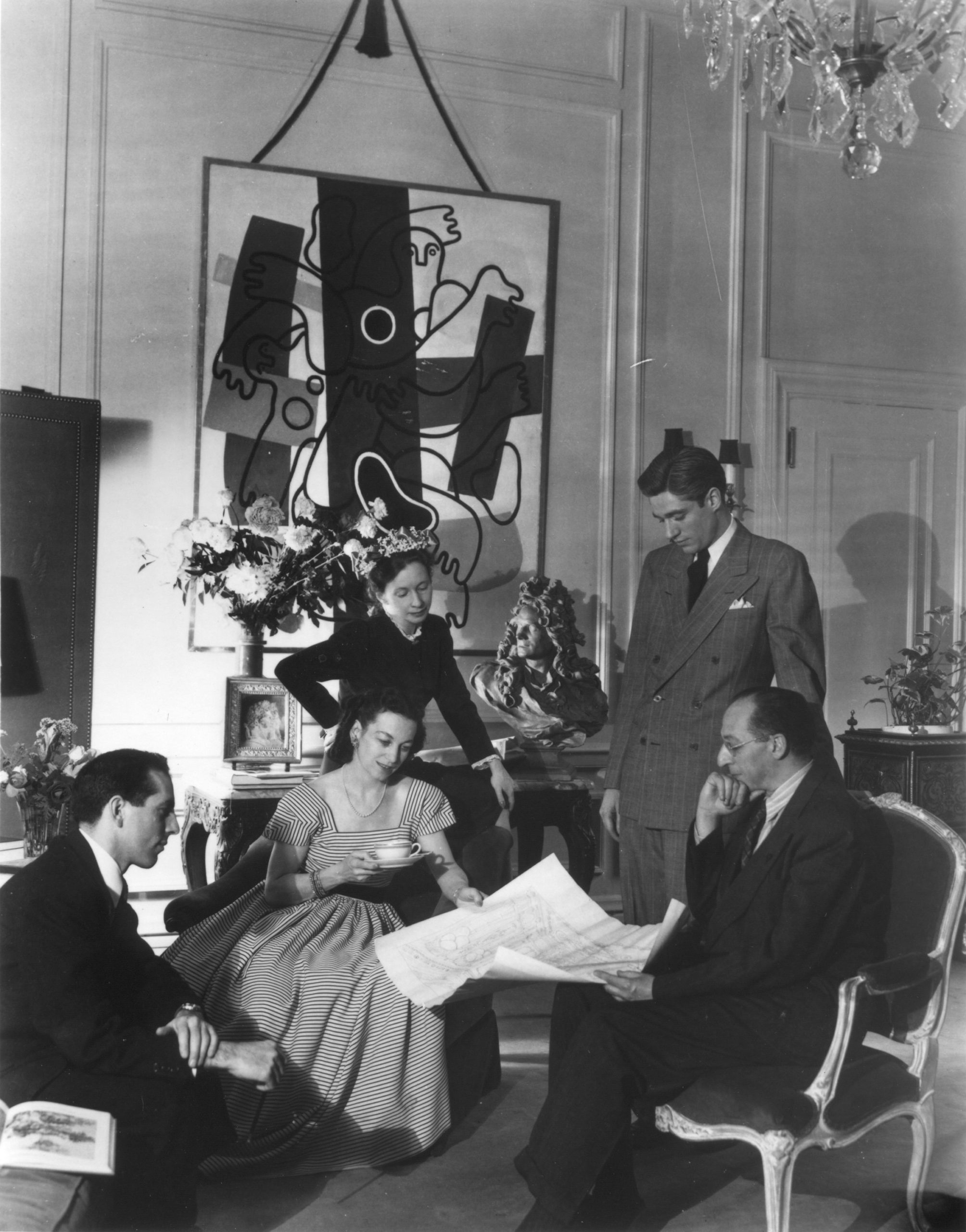Posted In
PrideOctober 20, 2021
During American Ballet Theatre’s 2021 Fall season, two special Pride Nights will be held on Wednesday, October 27 at 7:30pm and on Saturday, October 30 at 8:00pm in honor of Christopher Rudd’s Touché, a male pas de deux included in ABT’s “Rhythm and Rapture” program.
ABT's LGBTQIA+ Legacy
by Joseph Carman
A notable 1947 photo by bisexual photographer Cecil Beaton captures American Ballet Theatre’s nascent period, documenting five members of the Artistic Committee of Ballet Theatre gathering to inspect future plans for the Company. They include choreographer Agnes de Mille and Ballet Theatre co-director Lucia Chase. The other three are scenic designer and co-director Oliver Smith, choreographer Jerome Robbins, and composer Aaron Copland—all gay men.
From the beginning, ABT’s bloodline has flowed with the artistic enrichment of members of the LGBTQIA+ community.
As has been documented, queer artists throughout history have formidably shaped creativity in all art forms: music, the visual arts, costume and set design, theater, literature, film, television, and dance. What ABT’s LGBTQIA+ artists have bestowed on the troupe is estimable. In 1944, Robbins and the bisexual composer Leonard Bernstein collaborated on the seminal ballet Fancy Free, about randy sailors on shore leave, loosely based on the painting The Fleet’s In! by gay artist Paul Cadmus, with iconic sets designed by Oliver Smith. Their ingenious minds helped to accentuate the “theater” in Ballet Theatre, as it was known then. Adding to a legacy of dramatic ballets, Antony Tudor, whose life partner was ABT dancer Hugh Laing, choreographed ballets, such as Jardin aux Lilas and Dark Elegies, that formed a backbone of complex 20th century works in the repertoire.

Even recently, the early 20th century ballets by bisexual dancer/choreographers Leonide Massine (Gaîté Parisienne) and Vaslav Nijinsky (Afternoon of a Faun) have graced ABT’s repertoire. The homosexual impresario Serge Diaghilev curated a host of ballets for his Ballets Russes that have ennobled ABT’s programs, including Michel Fokine’s Les Sylphides, a signature work for ABT that appeared on the Company’s first program in 1940; and George Balanchine’s meatiest ballets for men, Apollo and Prodigal Son.
The beloved Frederick Ashton’s works have arrived more recently at ABT, including The Dream, Cinderella, and La Fille mal gardée. The latter two works by the late gay choreographer feature juicy drag roles with their respective sassy stepsisters and the clog-stomping Widow Simone. Contrast these to those often en travesti bitter bitches—the wicked fairy Carabosse in The Sleeping Beauty and Madge, the evil witch in La Sylphide.
Over the years, ABT hired LGBTQIA+ choreographers to create or restage ballets for the Company.
Among those were Alvin Ailey, John Neumeier, Peter Anastos, Glen Tetley (whose life partner was ABT dancer/ballet master Scott Douglas), Lar Lubovitch, Hans van Manen, and ABT dancer/choreographers Dennis Nahat, Kirk Peterson, John Meehan, and Clark Tippet. In addition to dancing with the Company, pansexual superstar Rudolph Nureyev restaged Paquita and Raymonda for ABT, and the late Frederic Franklin staged historic ballets for ABT over a period of time. During Mikhail Baryshnikov’s directorship, aided by his colorful assistant Charles France, he added quite a roster of formidable queer choreographers: Choo San Goh, Paul Taylor, Merce Cunningham, and Mark Morris. Later came Robert Hill, Ulysses Dove, John Cranko, Nacho Duato, and Christopher Wheeldon.
Ballet wouldn’t exist without inspiring musical scores, and Tchaikovsky’s brilliantly sensitive imagination brought us Swan Lake, The Sleeping Beauty, Theme and Variations, and The Nutcracker. Other LGBTQIA+ composers whose stirring scores have uplifted the Company’s ballets are Benjamin Britten, John Cage, Camille Saint-Saëns, John Corigliano, Francis Poulenc, Samuel Barber, Cole Porter, Gian Carlo Menotti, Virgil Thompson, and Nico Muhly. John Lanchbery orchestrated much of ABT’s classical repertoire and conducted the orchestra.
While Christopher Rudd’s Touché is groundbreaking at ABT for its rapturous, gay eroticism, gay-themed ballets have periodically appeared on ABT’s stages.
In the 1950s, director Herbert Ross choreographed The Maids, a ballet based on gay French author Jean Genet’s play, that featured two men as the murderous sisters. In 1973 the Company presented gay choreographer Rudi van Danzig’s Monument for a Dead Boy, which documents the torturous life of a young gay man. In 1982, ABT premiered Kenneth MacMillan’s The Wild Boy with its infamous homoerotic kiss. At the height of the AIDS pandemic, Lar Lubovitch set his duet from Concerto Six Twenty-Two on the Company, a male pas de deux that emphasized the intimate companionship of two men.
ABT suffered unspeakable losses throughout the AIDS crisis. So many dancers were taken by the disease: Peter Fonseca, David Cuevas, Clark Tippet, Charles Ward, Ian Horvath, Gary Cordial, William Carter, Gregory Osborne, Carld Jonassaint, Richard Cragun, and Rudolph Nureyev. The choreographers included Ulysses Dove, Alvin Ailey, and Choo San Goh. In the ABT family, we also lost Company pianist Lynn Stanford, organist Boyd Staplin, teachers and director of repertoire Woytek Lowski, makeup artist Leopold Allen, dresser Larry Ray, stage manager Jerry Rice, and Emile Ardolino, who directed ABT’s Live from Lincoln Center and Dance in America specials on PBS.
It must also be acknowledged that ABT lost an entire audience of fervent LGBTQIA+ fans during the AIDS plague. Replacing the collective wisdom and artistry of those taken by the disease is insurmountable.
In response to Russia’s so-called “gay propaganda” law, signed by Vladimir Putin in 2013, Mikhail Baryshnikov issued a statement published by the No More Fear Foundation, a U.S.-based non-governmental organization (NGO) for the protection of LGBT rights. “My life has been immensely enriched by gay mentors, colleagues and friends, and any discrimination and persecution of gay people is unacceptable,” he said. “Equal treatment of people is a basic right and it is sad that we still have to even speak about this in the 21st century.”
